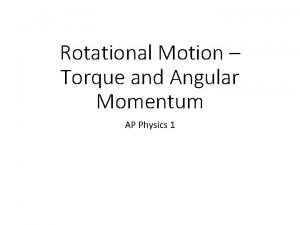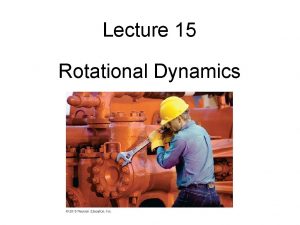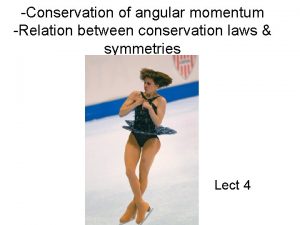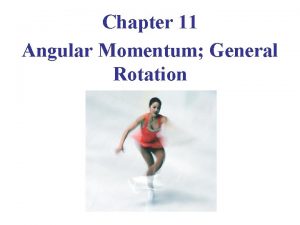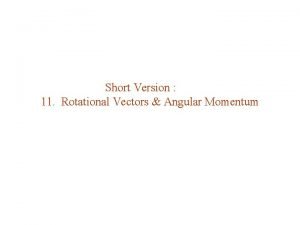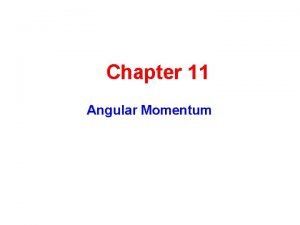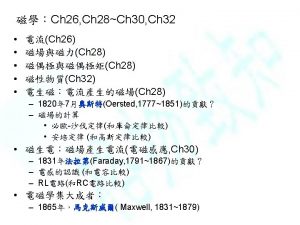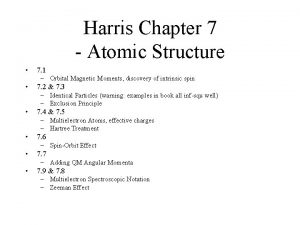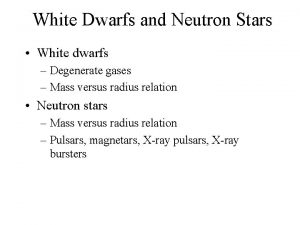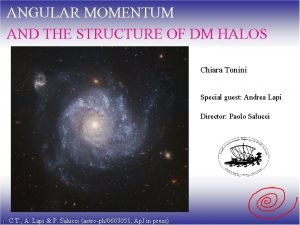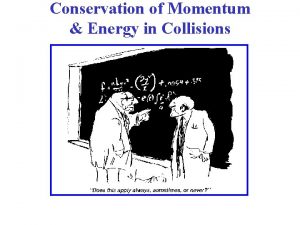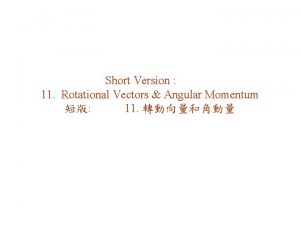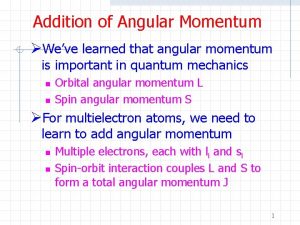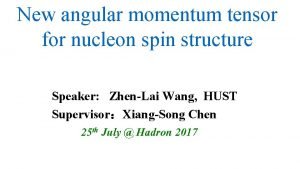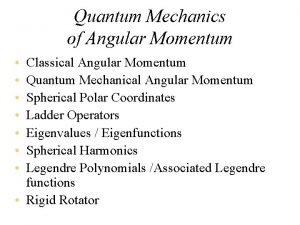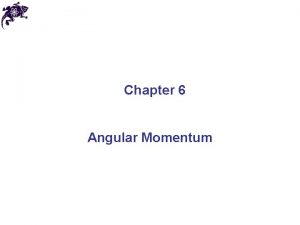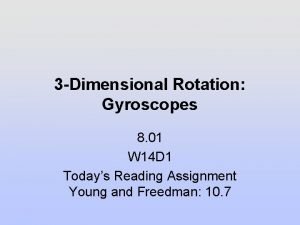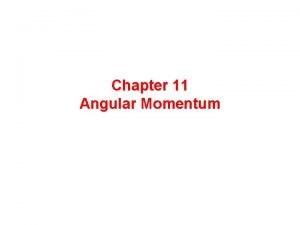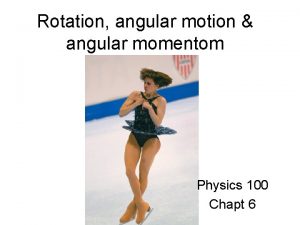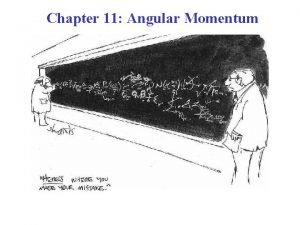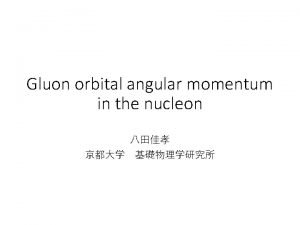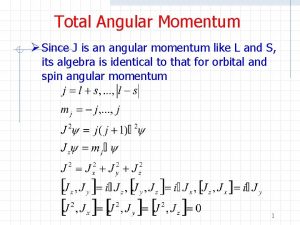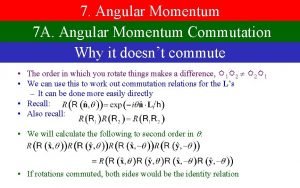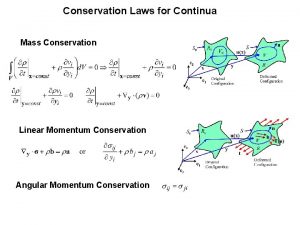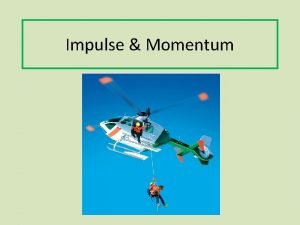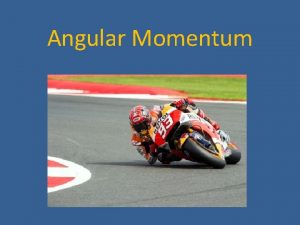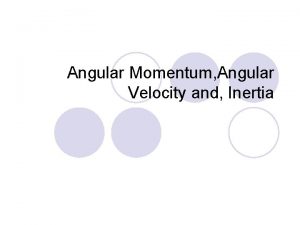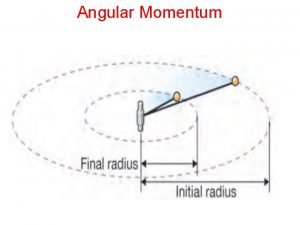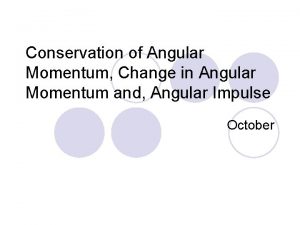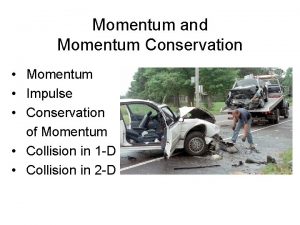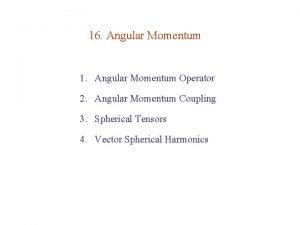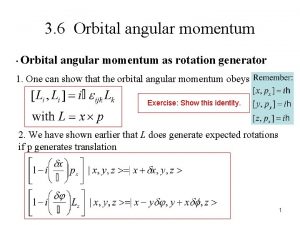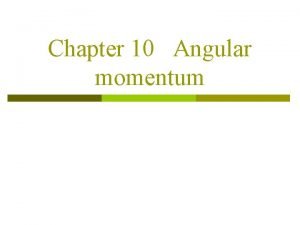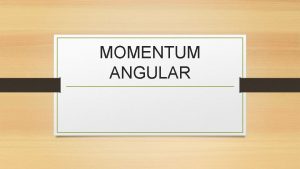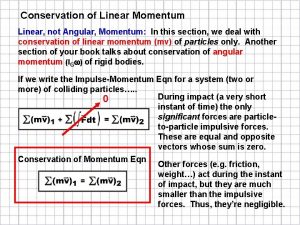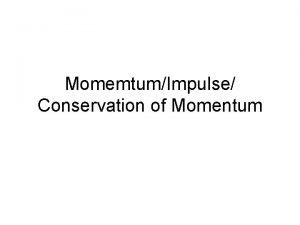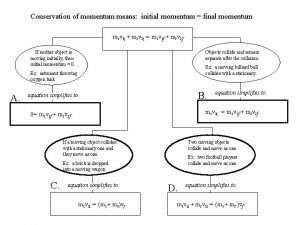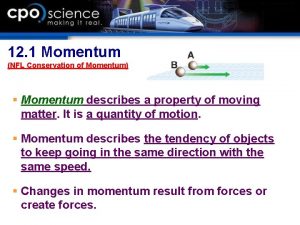Conservation of Angular Momentum 8 01 W 10

























- Slides: 25

Conservation of Angular Momentum 8. 01 W 10 D 2

Today’s Reading Assignment: W 10 D 2 Young and Freedman: 10. 5 -10. 6; Experiment 6: Conservation of Angular Momentum

Time Derivative of Angular Momentum for a Point Particle Angular momentum of a point particle about S: Time derivative of the angular momentum about S: Product rule Key Fact: Result:

Torque and the Time Derivative of Angular Momentum: Point Particle Torque about a point S is equal to the time derivative of the angular momentum about S.

Concept Question: Change in Angular Momentum A person spins a tennis ball on a string in a horizontal circle with velocity (so that the axis of rotation is vertical). At the point indicated below, the ball is given a sharp blow (force ) in the forward direction. This causes a change in angular momentum in the 1. direction 2. direction 3. direction

Angular Momentum for System of Particles Treat each particle separately Angular momentum for system about S

Angular Momentum and Torque for a System of Particles Change in total angular momentum about a point S equals the total torque about the point S

Internal and External Torques The total external torque is the sum of the torques due to the net external force acting on each element The total internal torque arise from the torques due to the internal forces acting between pairs of elements The total torque about S is the sum of the external torques and the internal torques

Internal Torques We know by Newton’s Third Law that the internal forces cancel in pairs and hence the sum of the internal forces is zero Does the same statement hold about pairs of internal torques? By the Third Law this sum becomes The vector points from the jth element to the ith element.

Central Forces: Internal Torques Cancel in Pairs If the internal forces between a pair of particles are directed along the line joining the two particles then the torque due to the internal forces cancel in pairs. This is a stronger version of Newton’s Third Law than we have so far used requiring that internal forces are central forces. With this assumption, the total torque is just due to the external forces However, so far no isolated system has been encountered such that the angular momentum is not constant.

Angular Impulse and Change in Angular Momentum Angular impulse Change in angular momentum Rotational dynamics

Conservation of Angular Momentum Rotational dynamics No external torques Change in Angular momentum is zero Angular Momentum is conserved So far no isolated system has been encountered such that the angular momentum is not constant.

Constants of the Motion When are the quantities, angular momentum about a point S, energy, and momentum constant for a system? • No external torques about point S : angular momentum about S is constant • No external work: mechanical energy constant • No external forces: momentum constant

Rotational and Translational Comparison Quantity Force Torque Kinetic Energy Momentum Angular Momentum Kinetic Energy Rotation Translation

Demo: Rotating on a Chair A person holding dumbbells in his/her arms spins in a rotating stool. When he/she pulls the dumbbells inward, the moment of inertia changes and he/she spins faster.

Concept Question: Twirling Person A woman, holding dumbbells in her arms, spins on a rotating stool. When she pulls the dumbbells inward, her moment of inertia about the vertical axis passing through her center of mass changes and she spins faster. The magnitude of the angular momentum about that axis is 1. 2. 3. 4. the same. larger. smaller. not enough information is given to decide.

Concept Question: Conservation Laws A tetherball of mass m is attached to a post of radius by a string. Initially it is a distance r 0 from the center of the post and it is moving tangentially with a speed v 0. The string passes through a hole in the center of the post at the top. The string is gradually shortened by drawing it through the hole. Ignore gravity. Until the ball hits the post, 1. The energy and angular momentum about the center of the post are constant. 2. The energy of the ball is constant but the angular momentum about the center of the post changes. 3. Both the energy and the angular momentum about the center of the post, change. 4. The energy of the ball changes but the angular momentum about the center of the post is constant.

Concept Question: Conservation laws A tetherball of mass m is attached to a post of radius R by a string. Initially it is a distance r 0 from the center of the post and it is moving tangentially with a speed v 0. The string wraps around the outside of the post. Ignore gravity. Until the ball hits the post, 1. The energy and angular momentum about the center of the post are constant. 2. The energy of the ball is constant but the angular momentum about the center of the post changes. 3. Both the energy of the ball and the angular momentum about the center of the post, change. 4. The energy of the ball changes but the angular momentum about the center of the post is constant.

Table Problem: Cross-section for Meteor Shower A meteor of mass m is approaching earth as shown on the sketch. The distance h on the sketch below is called the impact parameter. The radius of the earth is Re. The mass of the earth is me. Suppose the meteor has an initial speed of v 0. Assume that the meteor started very far away from the earth. Suppose the meteor just grazes the earth. You may ignore all other gravitational forces except the earth. Find the impact parameter h and the cross section ph 2.

Strategy: Impact Parameter 1. Draw a force diagram for the forces acting on the meteor. 2. Find a point about which the gravitational torque of the earth’s force on the meteor is zero for the entire orbit of the meteor. 3. What is the initial angular momentum and final angular momentum (when it just grazes the earth) of the meteor about that point? 4. Apply conservation of angular momentum to find a relationship between the meteor’s final velocity and the impact parameter. 5. Apply conservation of energy to find a relationship between the final velocity of the meteor and the initial velocity of the meteor. 6. Use your above results to calculate the impact parameter and the effective scattering cross section.

Demo: Train B 134 (1) At first the train is started without the track moving. The train and the track both move, one opposite the other. (2) Then the track is held fixed and the train is started. When the track is let go it does not revolve until the train is stopped. Then the track moves in the direction the train was moving. (3) Next try holding the train in place until the track comes up to normal speed (Its being driven by the train). When you let go the train remains in its stationary position while the track revolves. You shut the power off to the train and the train goes backwards. Put the power on and the train remains stationary. A small gauge HO train is placed on a circular track that is free to rotate.

Discussion Homework Problem A toy locomotive of mass ML runs on a horizontal circular track of radius R and total mass MT. The track forms the rim of an otherwise massless wheel which is free to rotate without friction about a vertical axis. The locomotive is started from rest and accelerated without slipping to a final speed of v relative to the track. What is the locomotive’s final speed, vf , relative to the floor?

Table Problem: Experiment 6 A steel washer, is mounted on the shaft of a small motor. The moment of inertia of the motor and washer is Ir. Assume that the frictional torque on the axle is independent of angular speed. The washer is set into motion. When it reaches an initial angular velocity ω0, at t = 0, the power to the motor is shut off, and the washer slows down during the time interval Δt 1 = ta until it reaches an angular velocity of ωa at time ta. At that instant, a second steel washer with a moment of inertia Iw is dropped on top of the first washer. The collision takes place over a time Δtcol = tb - ta. a) What is the angular deceleration α 1 during the interval Δt 1 = ta? b) What is the angular impulse due to the frictional torque on the axle during the collision? c) What is the angular velocity of the two washers immediately after the collision is finished?

Experiment 6: Conservation of Angular Momentum

Next Reading Assignment: W 11 D 1 Young and Freedman: 10. 3 -4
 Angular impulse-angular momentum theorem
Angular impulse-angular momentum theorem Conservation of angular momentum
Conservation of angular momentum Law of conservation of angular momentum
Law of conservation of angular momentum Angular momentum units
Angular momentum units Conservation of angular momentum
Conservation of angular momentum Torque and angular momentum
Torque and angular momentum The angular momentum is
The angular momentum is Orbital angular momentum
Orbital angular momentum Explain orbital angular moment
Explain orbital angular moment Angular momentum
Angular momentum Quantum angular momentum toy
Quantum angular momentum toy How do we know momentum is conserved
How do we know momentum is conserved Rolling torque and angular momentum
Rolling torque and angular momentum Orbital angular momentum quantum number
Orbital angular momentum quantum number Angular momentum tensor
Angular momentum tensor Angular momentum operators
Angular momentum operators Define angular momentum
Define angular momentum Flywheel angular momentum
Flywheel angular momentum Rolling torque and angular momentum
Rolling torque and angular momentum Right hand rule physics angular momentum
Right hand rule physics angular momentum Angular momentum is equal to
Angular momentum is equal to Angular momentum
Angular momentum Angular momentum
Angular momentum Angular momentum commutation
Angular momentum commutation Conservation of linear momentum
Conservation of linear momentum Principle of angular impulse and momentum
Principle of angular impulse and momentum
